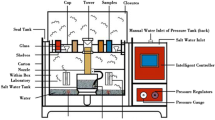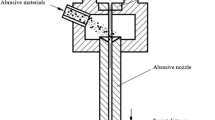Abstract
Surface properties directly affect the service life of heavy rail. The effect of ultrasonic impact energy and head shape on surface hardness, residual stress, morphology of heavy rail was investigated in this paper. 15 different impact processes and three impact head shapes of bar, single-pin head, and three-pin head were designed to treat the heavy rail surface by ultrasonic impact. The results showed that under three-pin head impact, the hardness of the ultrasonic impact area was 24.4% higher than the initial hardness at the process of 2.0 A, 60 s, and the minimum surface residual stress was − 642 MPa in the 2.5 A, 90 s. Finite element results indicated that the UIT (ultrasonic impact treatment) introduced beneficial compressive stress up to the depths of 1-3 mm. After ultrasonic impact treatment, the microscopic morphology of the heavy rail changed, resulting in a deformation of up to 1047.9 μm and a white layer.










Similar content being viewed by others
Abbreviations
- \(P_{1}\) :
-
Single impact power
- \(U\) :
-
Impact voltage
- \(I\) :
-
Impact current
- \(T_{{\text{i}}}\) :
-
Impact time
- \(n_{0}\) :
-
Impact frequency
- s :
-
Contact area
- P :
-
Total impact power
- F :
-
Impact force
- v :
-
Impact velocity
- \(m_{0}\) :
-
Weight of impact head
- a :
-
Acceleration
- t :
-
Single impact time
- \(\sigma\) :
-
Stress to evaluated
- A :
-
Initial yield stress
- B :
-
Hardening constant
- n :
-
Hardening exponent
- C :
-
Strain rate constant
- \(\dot{\varepsilon }\) :
-
Strain rate
- \(\dot{\varepsilon }_{0}\) :
-
Reference values of strain rate
- T :
-
Temperature under consideration
- \(T_{0}\) :
-
Temperature
- \(T_{{\text{m}}}\) :
-
Melting temperature
- m :
-
Thermal softening exponent
References
W.J. Wang, H.M. Guo, X. Du, J. Guo, Q.Y. Liu, and M.H. Zhu, Investigation on the Damage Mechanism and Prevention of Heavy-Haul Railway Rail, Eng. Failure Anal., 2013, 35, p 206–218.
Z.F. Liu, Y.Q. Wang, H.A. Ou, X.C. Yan, and Y.X. Luo, An Analytical Leveling Model of Curvature and Residual Stress Simulation for H-Beams, J. Constr. Steel Res., 2014, 102, p 13–23.
Y.Q. Song, W.W. Luo, and Y. Tao, Static Mechanics Analysis of no Bumping or Vibration Welding Structure Applied in High-Speed & Heavy-Load CWR with Single Inclined Surface, Sci. China: Technol. Sci., 2010, 53, p 3153–3160.
H. Song, P.L. Wang, L.H. Fu, M. Chen, Z.Q. Wang, and H.Y. Sun, Straightening Regulation Optimization on the Residual Stress Induced by the Compound Roll Straightening in the Heavy Rail, Shock Vib., 2010, 18, p 171–180.
T. Roy, A. Paradowska, R. Abrahams, M. Law, P. Mutton, M. Soodi, and W.Y. Yan, Residual Stress in Laser Cladded Heavy-Haul Rails Investigated by Neutron Diffraction, J. Mater. Process. Technol., 2020, 278, p 116511.
C.B. Biempica, J.J.D.C. Díaz, P.J.G. Nieto, and I.P. Sánchez, Nonlinear Analysis of Residual Stresses in a Rail Manufacturing Process by FEM, Appl. Math. Model, 2009, 33, p 34–53.
Y. Liu, J.C. Feng, S.P. Tan, Y. Cheng, and J. Hu, Investigation of Inhibition of Stress Corrosion Cracking of Welded Ti-6Al-4V Alloy using Electrochemical Noise, Int. J. Electrochem. Sci., 2020, 15, p 9204–9222.
N.A. Noda, K.J. Hu, Y. Sano, Y. Hosokawa, and X. Wang, Accuracy of Disk Method to Predict Roll Residual Stress by Measuring the Sliced Disk Stress, ISIJ Int., 2017, 57, p 1433–1441.
W.J. Wang, J. Hu, J. Guo, Q.Y. Liu, and M.H. Zhu, Effect of Laser Cladding on Wear and Damage Behaviors of Heavy-Haul Wheel/Rail Materials, Wear, 2014, 311, p 130–136.
Y.L. Zheng, Q.W. Hu, C.Y. Li, D.Z. Wang, L. Meng, J.G. Luo, J.P. Wang, and X.Y. Zeng, A Novel Laser Surface Compositing by Selective Laser Quenching to Enhance Railway Service Life, Tribol. Int., 2017, 106, p 46–54.
L. Meng, W.F. Zhao, K.L. Hou, D.H. Kou, Z.H. Yuan, X. Zhang, J.L. Xu, Q.W. Hu, D.Z. Wang, and X.Y. Zeng, A Comparison of Microstructure and Mechanical Properties of Laser Cladding and Laser-Induction Hybrid Cladding Coatings on Full-Scale Rail, Mater. Sci. Eng. A., 2019, 748, p 1–15.
D.A. Lesyk, H. Soyama, B.N. Mordyuk, V.V. Dzhemelinskyi, S. Martinez, N.I. Khripta, and A. Lamikiz, Mechanical Surface Treatments of AISI 304 Stainless Steel: Effects on Surface Microrelief, Residual Stress, and Microstructure, J. Mater. Eng. Perform., 2019, 28, p 5307–5322.
M.Y. Li, Q. Zhang, B. Han, L.X. Song, J.L. Li, and S.Y. Zhang, Effects of Ultrasonic Impact Treatment on Structures and Properties of Laser Cladding Al0.5CoCrFeMnNi High Entropy Alloy Coatings, Mater. Chem. Phys., 2021, 258, p 123850.
S.P. Chenakin, B.N. Mordyuk, and N.I. Khripta, Surface Composition, Structure and Corrosion Properties of a ZrTiNb Alloy: Effect of Impact Treatment Energy, Vacuum, 2023, 210, p 111889.
D.A. Lesyk, B.N. Mordyuk, V.V. Dzhemelinskyi, S.M. Voloshko, and A.P. Burmak, Optimization of Ultrasonic Impact Treatment for Surface Finishing and Hardening of AISI O2 Tool Steel by Experimental Design, J. Mater. Eng. Perform., 2022, 31, p 8567–8584.
F. Kahraman, H. Kahraman, C. Yolcu, and A.D. Kahraman, Wear Behavior of Ultrasonic Impact Treated S235JR Steel, Mater. Test., 2017, 59, p 445–449.
C. Liu, Q.L. Ge, D.J. Chen, F. Gao, and J.S. Zou, Residual Stress Variation in a Thick Welded Joint after Ultrasonic Impact Treatment, Sci. Technol. Weld. Joining, 2016, 21, p 624–631.
L. Li, M. Kim, S. Lee, M. Bae, and D. Lee, Influence of Multiple Ultrasonic Impact Treatments on Surface Roughness and Wear Performance of SUS301 Steel, Surf. Coat. Technol., 2016, 307, p 517–524.
X.Y. Yang, J.X. Zhou, and X. Ling, Study on Plastic Damage of AISI 304 Stainless Steel Induced by Ultrasonic Impact Treatment, Mater. Des., 2012, 36, p 477–481.
A. Berg-Pollack, F.-J. Voellmecke, and C.M. Sonsino, Fatigue Strength Improvement by Ultrasonic Impact Treatment of Highly Stressed Spokes of Cast Aluminum Wheels, Int. J. Fatigue, 2010, 33, p 513–518.
Q. Zhang, M.Y. Li, B. Han, S.Y. Zhang, Y. Li, and C.Y. Hu, Investigation on Microstructures and Properties of Al1.5CoCrFeMnNi high Entropy Alloy Coating Before and After Ultrasonic Impact Treatment, J. Alloys Compd., 2021, 884, p 160989.
Y.H. Xu, L. Fang, Q.H. Cen, and J.H. Zhu, Nano Structure and Transformation Mechanism of White Layer for AISI1045 Steel During Impact Wear, Wear, 2005, 258, p 537–544.
H. Nykyforchyn, V. Kyryliv, and O. Maksymiv, Wear Resistance of Steels with Surface Nanocrystalline Structure Generated by Mechanical-Pulse Treatment, Nanoscale Res. Lett., 2017, 12, p 150.
J.Y. Sun, X.Y. Mao, Z. Yang, X.M. Zhou, and X.M. Zhao, Effect of Gradient Microstructure on Wear Behavior of Carbon Steel, Mater. Res. Express, 2019, 6, p 126566–126566.
D.A. Lesyk, S. Martinez, B.N. Mordyuk, V.V. Dzhemelinskyi, A. Lamikiz, G.I. Prokopenko, M.O. Iefimov, and K.E. Grinkevych, Combining Laser Transformation Hardening and Ultrasonic Impact Strain Hardening for Enhanced Wear Resistance of AISI 1045 Steel, Wear, 2020, 462–463, p 203494.
A. Ramesh and S.N. Melkote, Modeling of White Layer Formation under Thermally Dominant Conditions in Orthogonal Machining of Hardened AISI 52100 Steel, Int. J. Mach. Tool Man., 2008, 48, p 402–414.
P. Walker, S. Malz, E. Trudel, S. Nosir, M.S.A. ElSayed, and L. Kok, Effects of Ultrasonic Impact Treatment on the Stress-Controlled Fatigue Performance of Additively Manufactured DMLS Ti-6Al-4V Alloy, Appl. Sci., 2019, 9, p 4787.
T. Tominaga, K. Matsuika, and K. Honma, Method of increasing strength of cold worked part by ultrasonic shock treatment, and metal product with high fracture toughness and fatigue strength. AU2003280853A1. 2004.
C.B. Guo, Z.J. Wang, D.P. Wang, and S.S. Hu, Numerical Analysis of the Residual Stress in Ultrasonic Impact Treatment Process with Single-Impact and Two-Impact Models, Appl. Surf. Sci., 2015, 347, p 596–601.
C.F. Yao, Y. Zhao, Z. Zhou, D.X. Wu, and Y. Wang, A Surface Integrity Model of TC17 Titanium Alloy by Ultrasonic Impact Treatment, Int. J. Adv. Manuf. Technol., 2020, 108, p 881–893.
C. Liu, J.B. Shen, C.H. Lin, J.F. Wang, and J.X. Wang, Experimental Investigation on the Subsurface Stress Distributions in Specimens with Different Strengths After Ultrasonic Impact Treatment, J. Mech. Sci. Technol., 2021, 35, p 2123–2129.
L.C. Xie, C.X. Wang, L.Q. Wang, Z. Wang, C.H. Jiang, W.J. Lu, and V. Ji, Numerical Analysis and Experimental Validation on Residual Stress Distribution of Titanium Matrix Composite After Shot peening Treatment, Mech. Mater., 2016, 99, p 2–8.
C.M. Zhao, C.J. Shi, Q. Wang, C.C. Zhao, Y.K. Gao, and Q.X. Yang, Residual Stress Field of High-Strength Steel After Shot Peening by Numerical Simulation, J. Mater. Eng. Perform., 2020, 29, p 358–364.
S.S. Hu, C.B. Guo, D.P. Wang, and Z.J. Wang, 3D Dynamic Finite Element Analysis of the Nonuniform Residual Stress in Ultrasonic Impact Treatment Process, J. Mater. Eng. Perform., 2016, 25, p 4004–4015.
T. Ohta, Numerical Analysis of Effect of Pin Tip Radius on Residual Stress Distribution in Ultrasonic Impact Treatment, Numer. Mater. Trans., 2018, 4, p 656–662.
Acknowledgments
The authors would like to appreciate the Fundamental Research Funds for the Hubei University of Technology and Key Lab of Modern Manufacture Quality Engineering, which supplied us the facilities and funds to fulfill the experiments. Thanked to Wuhan Heavy Duty Machine Tool Group Corporation for the support of residual stress, hardness, and microstructure measurement.
Author information
Authors and Affiliations
Corresponding author
Additional information
Publisher's Note
Springer Nature remains neutral with regard to jurisdictional claims in published maps and institutional affiliations.
Rights and permissions
Springer Nature or its licensor (e.g. a society or other partner) holds exclusive rights to this article under a publishing agreement with the author(s) or other rightsholder(s); author self-archiving of the accepted manuscript version of this article is solely governed by the terms of such publishing agreement and applicable law.
About this article
Cite this article
Xue, H., Liu, S., Zhang, D. et al. Effect of Ultrasonic Impact Treatment with Different Impact Energy and Head Shape on Surface Properties of U75V Heavy Rail. J. of Materi Eng and Perform (2023). https://doi.org/10.1007/s11665-023-08606-w
Received:
Revised:
Accepted:
Published:
DOI: https://doi.org/10.1007/s11665-023-08606-w




